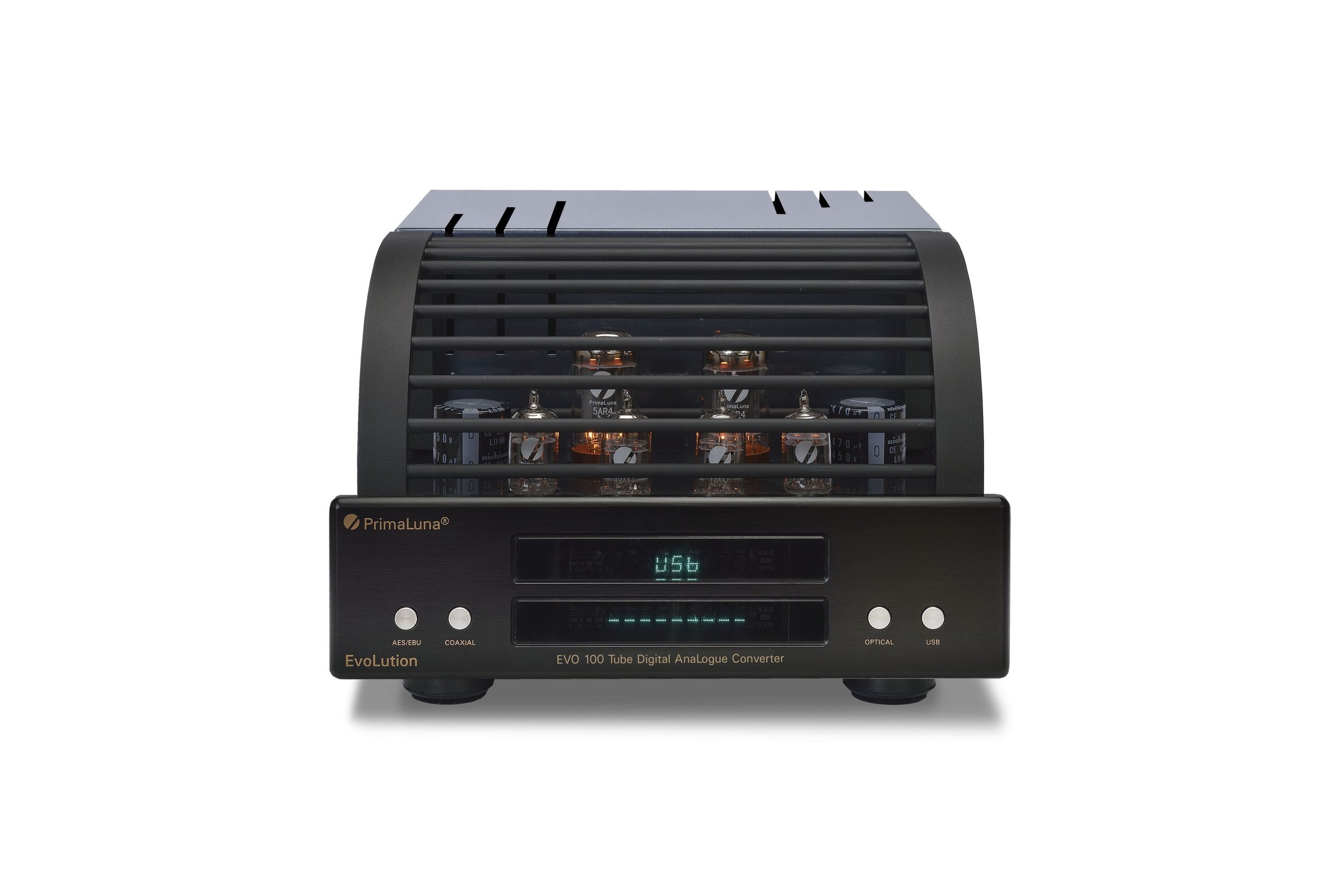SuperTubeClock
First a note on the tube itself: It is a very rugged, long-life Russian military triode specifically designed for oscillation purposes. Exactly its function in EVO 100. Life expectancy is roughly 5 to 10 years of operating time. The small glass envelope guarantees very low microphonics. Triode tubes are inherently low noise devices, and extremely linear when used properly. This means that the oscillation frequency wave it produces is very pure and clean. The noise in the sidebands, from 10Hz to 100kHz on either side of the oscillation frequency, is extremely low. Everything below and beyond that can be ignored.
When you re-clock the inputs, any noise generated here appears unfiltered and unattenuated at the input of the conversion chip, and injects jitter, which from then on is an indistinguishable part of the digital audio stream. No amount of cleaning will ever be able to remove this noise once it reaches this point; it becomes part of the audio signal. This noise "rides" on the audio signal so you do not hear it as noise, but as smearing of notes and masking of detail. There is a distinctive loss of dynamics, tonal purity, inter-transient silence, and sense of timing. We call this "noise modulation." This is why the low noise, especially in the 10Hz-100kHz sidebands of the oscillator, is so crucial. Again: Below and beyond these frequency extremes is trivial since it will not affect the audio, and will not reach the analog outputs.
When the clock is used to clock the DAC chip, a similar situation occurs as described above: the noise appears at the location where the digital audio stream is converted to successive steps in a staircase wave, which represents the analog audio signal. Each step has to be exactly 1/441000th, 1/96000th, 1/176400th, or 1/192000th. The injected noise introduces a deviation in time that is the exact replica of that noise. This means the audio signal at the outputs of the DAC chip has the noise riding on it, again as an inherent part of the signal. No amount of filtering will remove the noise once it reaches this step. Again, you experience that smear and detail masking, with a distinctive loss of dynamics, tonal purity, inter-transient silence, and sense of timing. This is why re-clocking both the inputs and the DAC chip makes complete sense.
The oscillation frequency wave produced by a tube is a sine wave. That's no good; it has to be converted to a square wave. When the rising and falling edges of a square wave are not steep enough, a certain window exists during which the actual transition of the data bit is not exactly time-defined. It leaves room to be either too late or too early. This is a partly random process, and partly dependent on surrounding conditions such as power supply voltage variations, ground noise, inherent CMOS or chip crosstalk in the decoder or DAC chip, etc. All these timing variations are noise, and are called jitter from various sources. The steeper the edges, the more exactly defined the transition moment will be, resulting in less noise (jitter). When a clock produces a very stable frequency with such low jitter, there will be a more accurate reproduction of the original analog waveform of the music.
For illustration purposes, imagine the SuperTubeClock generating a square wave at 8.4672MHz. The vertical slope is measured at ~500mV. The vertical peak-to-peak travel of the square wave at this frequency is 3.5 Volts, which is excellent. The faster a clock can go from peak to peak, the better. Square waves present themselves more and more like sine waves the higher you go in frequency. So, an 8.4672mHz wave is still identifiable as a square wave, but as you approach 42.2mHz, a square wave will be almost fully rounded off and appear as a sine wave. As a square wave begins to round off, it means the timing of the digital transmissions has become more insecure, allowing for the introduction of more noise and jitter that is then presented to the DAC.
Now, let's turn to a square wave generated by the SuperTubeClock at 42.2MHz. The square wave still has a very discernible square shape. This means the clock is very fast, leaving very little time to introduce jitter and noise that can interfere with sound quality as mentioned above. As seen on a scope, each black vertical line running from left to right represents five nanoseconds. The time it takes the slope to go from the top bar to the bottom takes up roughly 1/3 of that black square, which is about 1.67 nanoseconds. In other words, 1.6 billionths of a second. Each black horizontal line in this measurement represents ~1V from top to bottom. Just as in the first wave above, the peak-to-peak travel at 42.MmHz is about 3.6 volts. This kind of speed is crucial to ensure accuracy in detail retrieval. This in turn introduces less noise and jitter, resulting in better transients, increased clarity, improved dynamics, and a pure, musical tonality.
Inputs: USB, AES/EBU, Coax, Optical
Outputs: Stereo RCA
PCM (all inputs): 16bit-24bit, 44.1kHz-192kHz
DSD (USB): DSD64-DSD128 (DoP)
DSD (other inputs): DSD64 (DoP)
DAC: TI (Burr Brown) PCM1792A
24bit/192kHz Upsampling: TI (Burr Brown) SRC4192
Tube Complement: 2 - 12AX7, 2 - 12AU7, 2 - 5AR4
Dimensions (W x H x D): 11" x 7.5" x 15.9"
Weight: 28.7 lbs

